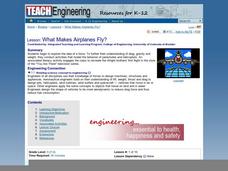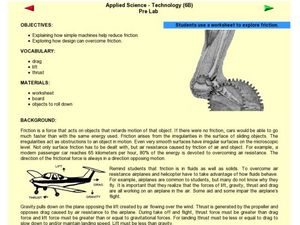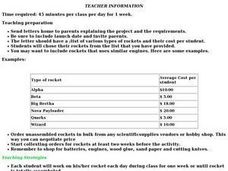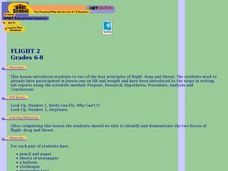Curated OER
Graphing the Four Forces
Using the Cartesian coordinate system, future flight experts plot points to determine whether or not an airplane will fly. With the four forces of weight, lift, drag, and thrust represented in different quadrants, your physics learners...
Curated OER
Crash Course in Flight
High school physicists demonstrate Bernoulli's Principle by blowing on different items and finding that they do not move in the expected direction! They apply Bernoulli's equation to the flight of an airplane. This well-organized lesson...
Curated OER
The Physics of Flight
Three activities allow young flight engineers to understand the 4 principles of flight (weight, lift, thrust, and drag), to construct a glider, and to create a propeller. Multicultural history and literature are integrated by reading...
Teach Engineering
Get Me Off This Planet
What do Newton's Laws have to do with getting from Earth to Mars?The activities in this resource show how Newton's Laws work with rockets to get them into space. Background information includes facts about orbits and how orbits...
Curated OER
What Makes Airplanes Fly?
Students examine force and conduct activities that model parachutes and helicopters. In this airplanes lesson students identify the forces that make airplanes fly higher and land.
Curated OER
Forces
These simple slides are basic, but clear, in their summary of physical forces. Definitions of friction, air resistance, gravity, freefall and projectiles are given along with a couple of helpful diagrams. More examples always help to...
Curated OER
Applied Science -Technology (6B) Pre Lab
Sixth graders discuss how simple machines overcome friction. In this simple machine lesson, 6th graders review the parts of a plane and how they make up for gravity and friction. They roll different objects down an inclined board...
Curated OER
Boomerangs Keep Coming Back
Students investigate the flight of paper boomerangs. In this flight lesson, students examine the flight variables of paper boomerangs, which they make, by investigating the concepts of lift and drag. They examine what happens when an...
Curated OER
Understanding the Four Forces of Flight
In this four forces of flight worksheet, students read a 1 page article on flights, answer 5 questions with multiple choice answers, draw a line to connect the four forces to their definitions and answer 1 short answer scenario.
Curated OER
Kite building activity
Learners explore how a kite flies; this lesson is a precursor for the windmill activity. By exploring how a kite flies, the students explore the power of the wind; particulary how drag, lifft and gravity enable objects such as kites and...
Curated OER
Design a Parachute
Students engage in a discussion about what a parachute is and how it works. They create a parachute using different materials that they think will work best. The students test their designs, which will be followed by a class discussion...
Curated OER
TE Activity: Heavy Helicopters
Young scholars study the concepts of weight and drag while making paper helicopters. They measure how adding more weight to the helicopter changes the time for the helicopter to fall to the ground. They apply what they examine to the...
Curated OER
Flight
Students are introduced to the four forces of flight--drag, lift, thrust, and weight--through a variety of fun-filled flight experiments. They "fly" for short periods and evaluate factors that might either increase or decrease their...
Curated OER
What Makes Thing Fly?
Second graders study lift, drag and thrust from a real flight instructor. In this physical science lesson students build and fly paper airplanes and experiment with variations and design.
Curated OER
DOWNHILL DISCOVERIES
Students studykinetic energy, friction, drag and acceleration by relating it to the Winter Olympics. In this physical properties lesson students create tracks and determine how the course conditions affect bobsled, luge and...
Curated OER
Does Shape Affect Drag?
Students study drag and how it affects a parachute in the sky. In this parachutes instructional activity students build models and compare their drag.
Curated OER
100 Years of Flight
Students investigate Bernoulli's principle of air pressure and how it
relates to the lift of an airplane. Students identify various Aeronautical vocabulary terms. Students construct a paper glider and experiment with the control surfaces...
Curated OER
The Drag of Drag
Students are told that any object moving through a fluid (air, water, molasses, etc) experience a drag force which oppose the motion. They are given the summarized version of drag which is proportional to the square of the velocity....
Curated OER
Building and Launching Rocket Kits
Students, in groups, build and decorate rocket kits and then launch them.
Curated OER
Flight 2
Learners are introduced to two of the four principles of flight: drag and thrust. As the class watches a video on these principles, they utilize ballons, straws and clothepins to simulate what they're seeing in the show. Nice, hands-on...
Curated OER
How the force of air helps an airplane fly.
Students appropriately the following terms in sentences: drag, thrust, gravity, aerodynamics and lift.
Curated OER
Numerical Determination of Drag Coefficients
Young scholars create a video of an object falling with a drag. In this physics instructional activity, students calculate drag coefficient using data from Logger Pro. They calculate velocity and acceleration of the object.
Curated OER
Friction- What a Drag
Students explore friction. In this friction lesson, students investigate that weight and surface type affect friction.
Curated OER
Four Forces of Flight
Young scholars explore the four forces of flight. They investigate the four forces of flight: lift, drag, thrust and weight (gravity). They experiment with flight-testing various objects commonly found around the house and constructing...

























